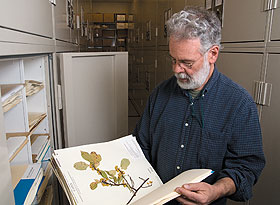  |
| HOME | THIS ISSUE | CALENDAR | GRANTS | BACK ISSUES | < BACK | NEXT > |
UConn efforts help curb spread of invasive plants in stateby Elizabeth Omara-Otunnu - February 23, 2009
|
||||
| You see them in the parking lots of retail chain stores and fast food outlets – neat shrubs with glowing scarlet leaves in fall and bright crimson berries in winter. Burning bush is beautiful but, as many people now know, it’s one of a growing number of invasive plant species that are threatening indigenous ecological systems.
In Connecticut, that public awareness owes much to the efforts of UConn’s Les Mehrhoff and Donna Ellis. “Euonymus – burning bush – is planted everywhere,” says Mehrhoff, director of the Invasive Plant Atlas of New England (IPANE) in the ecology and evolutionary biology department. “There’s not a McDonald’s or Burger King without them. The plant’s a money maker – it’s easily grown, resists pests, and it’s beautiful.” The problem is that birds love the fruits, which are high in energy and fats. They fly off and spread the seeds, and now the plant is growing in numerous unmanaged habitats. Mehrhoff says he became aware of invasives in the 1990s, while working on endangered species. “I started seeing a lot of habitats being encroached by invasive species,” he says. In 1997, he and Ellis, a senior extension educator in the plant science department, established an advocacy group to focus on the issue. The Connecticut Invasive Plant Working Group (CIPWG) began with about 30 members, including faculty from UConn and other colleges, and representatives of The Nature Conservancy, the Connecticut Agricultural Experiment Station, municipalities, state and federal agencies, and garden clubs. It now has a listserv of more than 500. UConn is also represented on a state-mandated council, the Invasive Plants Council, a nine-member group that is currently chaired by Professor Mary Musgrave, head of the plant science department. “There are a lot of people in the state who care,” says Mehrhoff. During the past 10 years, Mehrhoff and Ellis have played a leading role working with these two groups to identify invasive plants, and take action to address the problem. An official list has been compiled of 96 non-native plants considered invasive or potentially invasive in Connecticut, 81 of which are now banned by law from being sold, purchased, transplanted, or cultivated in the state. These include Japanese barberry, Asiatic bittersweet, purple loosestrife, and other, less showy plants, such as garlic mustard and mile-a-minute vine, newly recognized as invasive. The work is sometimes controversial. Not everyone agrees on all the species that are invasive, Mehrhoff says. In addition to ecological considerations, there are economic issues at stake. “Some are big money plants for the nursery industry or the aquatic trade,” he says. “Some aquatic species are sold in every pet store.” One of the primary reasons efforts in Connecticut have succeeded, according to Mehrhoff, has been the involvement of UConn faculty and staff. “The imprimatur of professionalism and academics that comes from this work being conducted at the University has been key to its success,” he says.
Plant science professor Mark Brand, ecology and evolutionary biology professor John Silander, and others have worked to establish the criteria for labeling a plant as invasive, based on its biology, and to document its occurrence in the state. “If growers see something on the list, they know it’s there for a good reason,” Mehrhoff says. “There’s science behind it.” Although efforts have focused on Connecticut, their scope goes beyond state boundaries. In 2002, Mehrhoff launched the Invasive Plant Atlas of New England, a USDA-funded initiative to track the distribution and spread of more than 100 invasive plant species throughout the region. The Atlas is now part of a virtual network of invasive species programs nationwide. UConn people are also coordinating efforts to eradicate invasive species, offer alternatives, and spread the word to the public. “We’re working with the nursery industry and the public to educate them about the plants on the list,” says Ellis. The Connecticut Invasive Plant Working Group web site (http://www.hort.uconn.edu/CIPWG) includes lists of invasive plants in the state, criteria for identifying them, photographs, legislative information, invasive plant alerts, and information about who to contact with questions. There is also a list of publications, including a management guide to the different types of control appropriate for each species. In addition, Ellis and Brand are now developing a campus walking tour – both real and virtual – that identifies invasive plant species along the way. For those species used in horticulture, Ellis helps spread the word about alternatives. “Native plants are becoming more important in the landscape because of their links to wildlife,” she says. “Another gardening option is using non-native plants that are not invasive.” UConn researchers Brand and another plant science professor, Yi Li, are developing alternatives to Japanese barberry, cultivars that have similar aesthetic properties but are not invasive. Mehrhoff and Ellis say it’s important to find invasive plants early. “With early detection and rapid response – like in the medical industry – the prognosis becomes much better,” says Mehrhoff. “Even small-scale actions can make a difference,” adds Ellis. “At least you’re cutting down on the future supply of seeds that can start new plants in other areas.” Mehrhoff says invasive species control can be costly, but the cost of not taking action may be higher. “You can’t easily put a monetary value on the loss of native species that are outcompeted by invasive species,” he says. “Native biodiversity is our natural heritage. Invasives are changing the integrity of the whole system. We are trying to slow that process and where possible, put a stop to it.” Feb. 23-27 is National Invasive Weeds Awareness Week. |
| ADVANCE HOME UCONN HOME |


